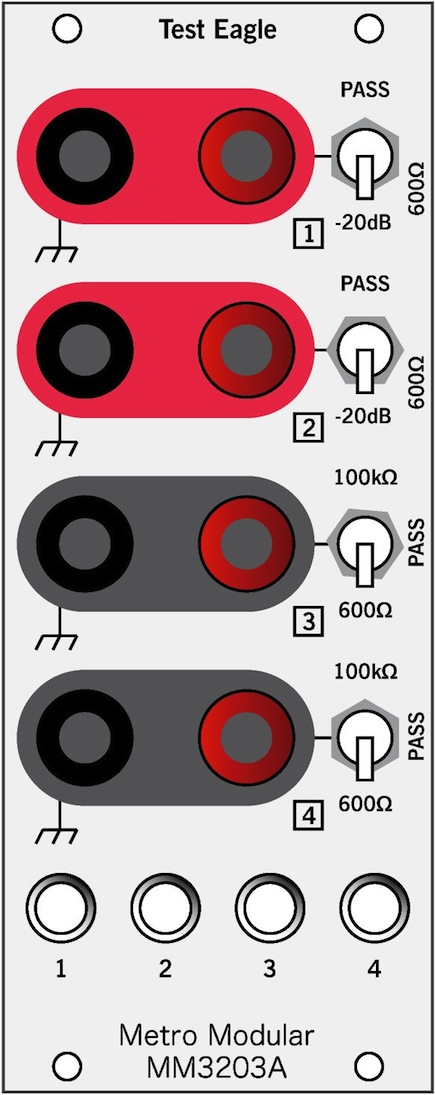All about it
"Let the eagle soar...."
- John Ashcroft
I had been using rough and-ready banana-to-minijack adaptors, with all the connectors hanging off the leads of a 100k load resistor, to connect multimeters to CV sources for calibration purposes for years. With the acquisition of a large quantity of old test oscillators and lab equipment, I started to think about something more sophisticated....
There are already some great options in the Euro market for interfacing banana jack modular to minijack, but I felt there was an untapped niche for something specialised in interfacing lab and test equipment as well as DIY prototyping setups to and from Eurorack, and this idea guided the design in the following ways.
Firstly, the standard retail version uses high quality Pomona recessed panel-mount banana jacks. These are more solid than the relatively inexpensive Johnson jacks used in both classic and modern "west coast" synths (machined solid insert rather than stamped sheet metal). As an option, it is possible to substitute Pomona double binding posts, which will interface just fine to standard banana jacks but also have screw terminals which can either connect jumper wires from breadboards or attach load resistors of your choosing, as well as connecting banana jacks!
Secondly, each signal connector (red) has a paired ground connector at the industry-standard 3/4 inch spacing which permits the use of dual banana plug test leads or BNC coax adapters which can be readily sourced through eBay.
Thirdly, each interface has a switchable shunt load.
Interfaces 3 and 4 can switch in either a precision 100k ohm resistor (to ensure that CV signals being sent to multimeters have a standard input load for accurate calibration, or a 600 ohm resistor for ensuring that older transistorised signal generators have a standard output load to work properly when they connect to Euro (and their output levels are attenuated to safe levels). The centre position of each switch is a no-load passthrough setting, for connecting bananafied modular synths to your Euro or where you have external termination (ie 50 ohm coax).
Interfaces 1 and 2 are a bit more specialised. These are designed for interfacing older valve equipment which can produce huge voltages and power outputs without breaking a sweat-enough to make life unpleasant for a Eurorack setup. Therefore these interfaces have two switch settings for 600 ohm load-the lower of which divides the input signal by 10 for a -20dB input pad. This will make input levels safer, indeed any signal generator which outputs 5W or less into a 600 Ohm load can safely connect to a Euro synth via this setting. The top switch setting is an unterminated, unattenuated passthrough setting.
Tech Notes
This is noteworthy as proof of how motivating a deadline to present at a synth meet can be-this went from a bright idea walking home at night to a completed fully working prototype with production-ready laser-cut panel design (albeit point-to-point wired!) within a week, just 12 hours before its public debut. About 3 months less than normal to reach this stage!!!
All 100k ohm loads are 0.1% precision 15ppm metal-film Neohm resistors; all 600 ohm loads are made from 1% industrial-grade resistors - 5 watt Ohmite WH wire-wound and Dale CMF metal film, with 2% Vishay CCF07 used for value trimming.
Toggle switches are high-quality NKK M series (as always!) - gold contacts for inputs 3 and 4, silver contacts for inputs 1 and 2
Tech Specs
Configuration options
Option 010: Pomona 4243 dual binding posts instead of jack sockets; slightly enhanced accuracy of 600 ohm load in inputs 1 and 2; and 9" Quickconnect 14AWG grounding cable included
Power requirements
+12V: Not required
-12V: Not required
+5V: Not required
Euro-standard 10-pin shrouded male connector and ribbon cable provided for connection to supply ground (strongly recommended!). Quickconnect spade lug provided for optional low-resistance grounding.
Dimensions
Eurorack standard, 10HP width
38mm depth below mounting rails with supplied Euro grounding cable
Operation
User guide v1.01 (December 2016) [Print double sided and flip on short edge]
Option 10 user guide v1.02 (December 2016) [Print double sided and flip on short edge]
Handwerk
Arbeit
In production, on sale
Produkte
Watch this space

